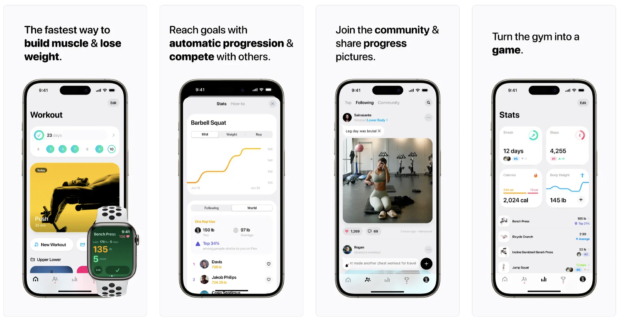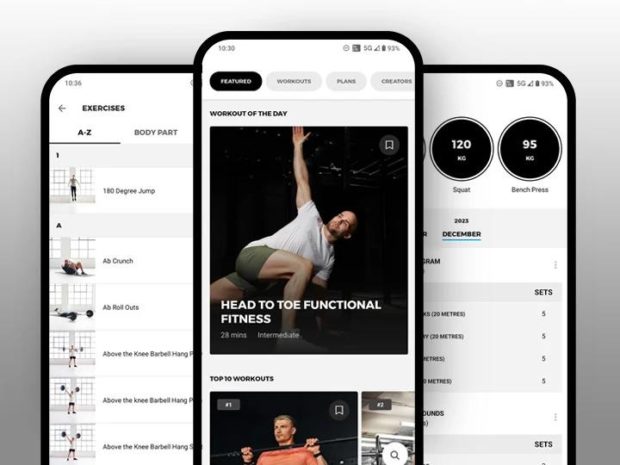With increased awareness of how sedentary lifestyles are affecting us and after being forced to stay indoors since 2020, many people turned to fitness tracker apps to keep a check on their fitness goals and habits. There’s good evidence to show that the fitness app industry is expanding in scope.
According to data from Statista, the fitness apps market worldwide is expected to hit USD 6.68 billion in 2024. The projected annual growth rate is 9.99% per year— with an expected market volume of USD 10.04 billion by 2028.
The integration of artificial intelligence into the fitness sphere, too, has begun to shift the benchmark for what personal fitness should look like in the future.
Trends like biohacking and fitness wearables are on the uptick and emergent technologies like robot personal trainers are being tested out within the space.
Gamification too— harnessing the element of fun in tasks like working out, which may feel mundane if it’s not a habit— is taking the fitness world by storm on popular exercise tracker apps like Flex and Strava.
When it comes to spending time in the gym, though, many people still keep mental logs of their exercises or stick to trusty pen-and-paper tracking methods.
However, this causes people to miss out on the best way to make effective progress. Great workouts, if not tracked properly, don’t allow people to make consistent and sustainable fitness progress.
Tracking has become more important than ever. To get a sense of those who are doing tracking right, here are some of the best fitness tracker apps poised to take over the market harnessing AI capabilities and staying at the helm of 2024’s emerging industry trends.

Flex
Flex essentially serves the function of a pocket-sized personal trainer. One of the key reasons people try and fail to stick with good workout routines and fitness habits is lack of motivation.
This app completely tackles the motivation problems people have in the gym by turning fitness into a game. The Flex social sharing community has a just-like-the-gym feel that keeps even the least-eager user engaged.
The app recently unrolled a new leaderboard feature, allowing users to compete among users of similar ages, weights, and genders to build positive workout habits while introducing a competitive element.
It’s geared toward weightlifters, but Flex provides above-and-beyond tracking abilities for things like home workouts and stretch routines too.
Although newer than stalwarts like Strava, Flex’s leaderboard features help set it apart as one to watch among the best fitness tracker apps of 2024.
The Flex blog also covers everything from fitness industry trends to scientific concepts and techniques for optimizing your workouts. Using these as a guide, users will gain insight into how this makes complicated exercise techniques completely accessible, even for fitness beginners.
Flex comes in at only $9.99 per month or $59.99, making it one of the most cost-effective options industrywide.

Strava
At the rate it’s going, Strava is one of the best-established competitors in the fitness industry.
Strave allows simple, social route tracking that lets users network with others, plan routes and set records within their communities.
This app is great for what it is advertised for: helping runners and cyclists track their routes, discover new local training courses and build community.
Although it certainly delivers on community features, Strava does have fewer privacy options than other apps for users who may want to share less of their workouts with others.
For social athletes who enjoy a community focus, Strava remains one of the best options, however, if you prefer to work out in private, other apps are more geared toward solo workouts.
Strava retails for $11.99 per month or $79.99 per year.

The Peloton app has a strong range of classes across exercise types. Here, you can work on yoga, cardio, HIIT workouts or even boxing.
Where Peloton loses some points is in pricing. Although the app specifies that you don’t need a bike or rowing machine to participate, if you do want to add these devices, it will cost.
Although the app does have a free version, the paid upgrades all include significant financial jumps. This app just introduced new pricing, with the Peloton App One version coming in at $129 and the Peloton App Plus at $240 per year.
You do pay for quality, but these premium prices set the app at one of the higher retail costs on the market.

For a face-to-face touch, Future is one of the best personalized coaching apps on the digital fitness market in 2024.
Here, you get to connect with a coach through the app and receive tailor-made advice from highly experienced coaches. For those who struggle with accountability, the approach of one-on-one coaching is a style that is likely to resonate.
Future combines AI workout plan design with a human element, capturing a middle ground that people who need an extra push will appreciate.
Coaches can check in with users to see how they are feeling during their fitness programs and assess whether changes need to be made to their plans.
Future is a fair bit pricier than most apps on the market. At $199 per month, the steep cost may be offputting to some, but for those who work best with expert guidance, Future is worth the cost of admission.

From the makers of Gymshark clothing, the Gymshark Training app is a solid option for fitness beginners.
As of now, the app is 100% free and is an accessible option from a cost perspective. That being said, there are a few fixes that would render the app more user-friendly.
Gymshark is missing a usable calendar feature for users to compare and contrast workout data over time. Compared to an app like Flex that offers robust calendar data, this sets the app back.
Developers, however, note that the Gymshark app continues to be a work in progress. As one of the best-known brands in the fitness fashion industry, Gymshark has solidified its reputation as an innovator, so seeing promising growth from the app in 2024 has a promising outlook.
Choosing the Best Fitness Tracker App
With all these benefits available, it may be challenging to pick the perfect app. Fortunately, many of these fitness tracker options allow trial periods for users to asses their relative value.
If you are choosing among the handful of apps currently on the market, consider your budget, fitness goals, and time constraints.
These “big three” factors can serve as a guide for what type of fitness plan you are reasonably able to adhere to.
Future of Fitness
Artificial intelligence has completely disrupted the market for fitness trackers in 2024. With wearables, gamified user experience and total personalization taking over, competitive apps will need to provide social-first services to keep their users coming back.
What apps like Flex, Strava and Peloton are doing now is taking the guesswork out of fitness, making it simple and accessible for users of different fitness levels with a range of abilities and health considerations.
With exceptional user experience options and gamified challenges, fitness frontrunner apps are demonstrating that “general” doesn’t work anymore in the fitness world. Those who wish to remain relevant will have to pick up the pace.
Members of the editorial and news staff of the Daily Caller were not involved in the creation of this content.


